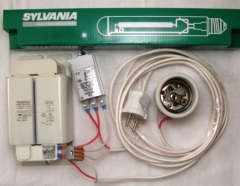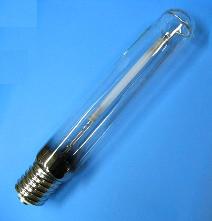Categories: Featured Articles » Sources of light
Number of views: 28629
Comments on the article: 0
Sodium lamps: dominance of the tamed chemical element
 The article discusses the design and application of high-pressure sodium lamps.
The article discusses the design and application of high-pressure sodium lamps.
It is difficult today for astronomers. No matter where in the sky they are oriented by telescopes, the lines of sodium and mercury will always be present in photographs of the spectra of stars. Such spectra do not at all prove that stars are rich in these chemical elements. The reason is purely earthly: the external illumination of cities and freeways with the help of high-intensity discharge lamps creates such a strong illumination of the atmosphere that sensitive astronomical instruments capture the light of man-made “stars”.
The biggest contribution to street lighting, and the main obstacle to astronomical observations, are today high pressure sodium lamps. About them and will be discussed in this material.
First of all, why exactly high pressure? The fact is that discharge tube lamps with low mercury pressure appeared in the prewar period. Fluorescent lamps quickly became widespread. But a discharge in sodium vapor for a long time could not be obtained due to the low partial pressure of sodium at low temperatures.
After a number of technological tricks, the distinction is to create sodium lamps operating at low pressure. But they were not widely used due to the complex design. A more fortunate fate high pressure sodium lamps (NLVD). Initial attempts to create lamps in a quartz glass shell ended in failure. At high temperatures, the chemical activity of sodium increases. The mobility of its atoms (diffusion) is also growing. Therefore, in quartz burners, sodium quickly penetrated through quartz, destroying the burner shell.
The situation was measured when in the early 60s, General Electric patented a new ceramic material that can work in sodium vapor at high temperatures. He received the brand name “Lukalos”. We have this ceramics known as Polycor. Ceramics are made by high temperature sintering of alumina powder.
Alumina has more than 10 modifications of the crystal lattice, depending on the conditions of the oxidation reaction. For lighting purposes, only one modification is suitable - the alpha form of the oxide, which has the most dense packing of atoms in the crystal. The sintering process, or rather the “growing" of ceramics is very moody. Indeed, in addition to chemical resistance to sodium vapor, ceramics should have high transparency. What is the point of making a lamp if most of the light is lost in the walls of the discharge tube (burner)?
 The ceramic burner of sodium lamps is the main distinguishing feature from other gas-discharge light sources. Ceramics operating at temperatures of more than 1000 degrees, can retain sodium for tens of thousands of hours. But this does not mean that sodium is not at all able to penetrate outward into the volume of the outer flask.
The ceramic burner of sodium lamps is the main distinguishing feature from other gas-discharge light sources. Ceramics operating at temperatures of more than 1000 degrees, can retain sodium for tens of thousands of hours. But this does not mean that sodium is not at all able to penetrate outward into the volume of the outer flask.
A dense crystal lattice really impedes the diffusion of atoms through ceramics. But the crystalline blocks of aluminum oxide are “bonded” to each other by amorphous, glass-like interphase ceramics. It consists of additives that limit the growth of polycor crystals and impurities that are unavoidable in any material. Permeability along the boundaries of crystals is much higher than through a crystal lattice. Therefore, the life of sodium lamps is determined precisely by the loss of sodium through intercrystalline material.
For sodium lamps are used and single crystals of aluminum oxide - “monocor”, better known as sapphire.Discharge tubes made of such a material have a very high transmittance, high resistance to sodium diffusion, but anisotropic (different directions) mechanical properties make it difficult to seal burners with high-temperature cements. In addition, they are noticeably more expensive than polycrystalline burners.
 The sodium lamp burner has only two electrodes on which an emission coating is applied to facilitate the initial ignition of the lamp. An inert gas (usually xenon at a pressure of about 20 mm Hg) and an amalgam (alloy) of mercury with sodium are dosed into the burner, in the form of a ball of strictly fixed composition and size.
The sodium lamp burner has only two electrodes on which an emission coating is applied to facilitate the initial ignition of the lamp. An inert gas (usually xenon at a pressure of about 20 mm Hg) and an amalgam (alloy) of mercury with sodium are dosed into the burner, in the form of a ball of strictly fixed composition and size.
The lamp life is directly related to the life of the burner. And that, in turn, is determined by the stock of sodium and the emission composition at the electrodes. Over time, sodium leaks through the ceramics, which leads to an increase in the voltage on the burner, which causes the lamp to die out immediately after entering the mode.
After cooling, the lamp flashes again to go out again. Frequent operation (short on-off cycles) leads to accelerated consumption of the emitter - emission composition on the electrodes and the lamp fails.
The burner is mounted in an outer flask made of refractory glass on the traverses (supports). After evacuation and desoldering, the base is attached to the flask (usually E27 or E40). The volume of the outer flask is evacuated. To obtain a higher vacuum, a getter composition — getter — is additionally sprayed in it.
Vacuum insulation of the burners is necessary to protect the refractory metals of the burner structure (niobium, molybdenum) from oxidation. But the main task is to eliminate the heat loss by convection. After all, ceramics operating at temperatures above 1000 degrees become a powerful source of thermal energy. With poor thermal insulation, the lamp efficiency decreases, the bulb and lamp base overheat.
A wide range of sodium lamps from 35 to 1000 watts is now available. Three main groups of sodium lamps can be distinguished according to the shape of the external bulb and application features: DNaT with a tubular bulb, DNaS with an elliptical frosted shell and DNaZ with a mirror reflective coating.
 About application high pressure sodium lamps it’s not worth special mention: it is street lighting of settlements, busy highways and highlighting of architectural ensembles.
About application high pressure sodium lamps it’s not worth special mention: it is street lighting of settlements, busy highways and highlighting of architectural ensembles.
Lamps DNaS developed as a replacement for arc mercury fluorescent lamps (DRL). In addition to the elliptical shape of the flask, they have the peculiarities of filling the burners: instead of pure xenon, a mixture of noble gases (Penning mixture) is dosed to facilitate ignition. Such lamps are operated without an ignition device generating high voltage pulses. Other types of sodium lamps need a similar device.
Lamps DNAZ found application in industrial greenhouses to accelerate plant photosynthesis. The share of these lamps in the total number of sources using sodium radiation is relatively small, and they can be attributed to special lamps.
With very high efficiency and good color rendering, low-power sodium lamps (35 and 50 W) could well find application in everyday life. Additives to the burner of rare-earth metals make it possible to obtain a radiation spectrum that is almost indistinguishable from sunlight.
But the Achilles heel of the lamps is not a complicated power scheme - modern electronics can easily cope with a similar problem. The time of acceleration and exit to the operating mode is an obstacle that negates all the advantages of sodium lamps in everyday life. Low-power lamps go into 4-6 minutes, and fully parameters stabilize within 20-25 minutes. To come to terms with such inconveniences in the lighting of rooms, rarely will anyone agree.
To date, there are practically no other alternative light sources for outdoor lighting.Sodium lamps will occupy this niche for a long time, condescendingly looking at attempts modern “upstarts” such as LED lights press them out.
See also at bgv.electricianexp.com
:
